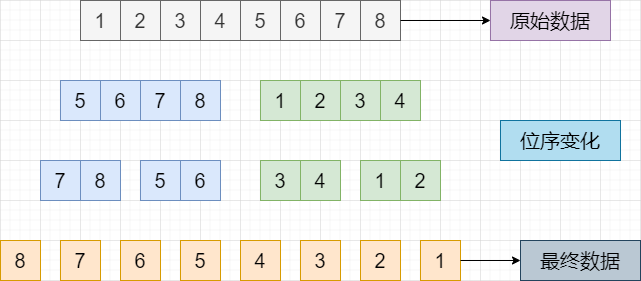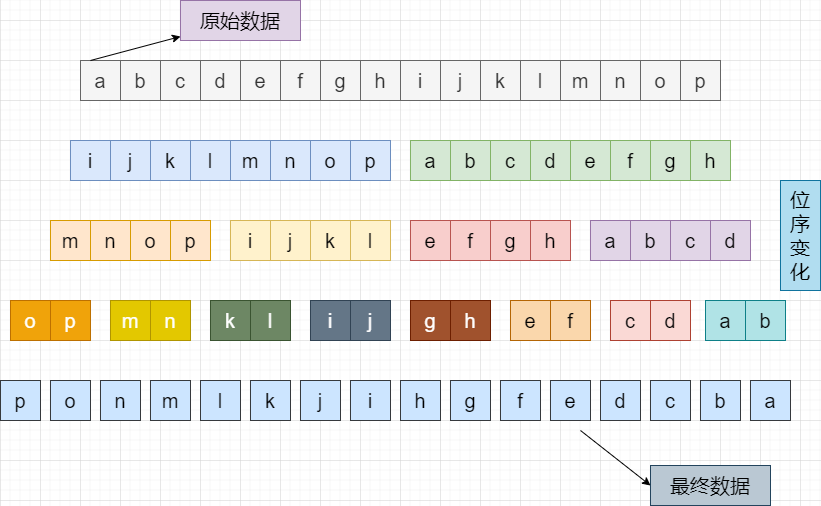Follow+Star Public Account, don’t miss out on exciting content

Source | Technology Makes Dreams Greater
Recently, I encountered the issue of byte high-low bit conversion in a protocol, so I lazily searched online and found a similar problem, and learned a new term called butterfly swapping.
The protocol requires that the low byte is on the left and the high byte is on the right, performing conversion processing for each byte, swapping its high and low bits one by one. For example, 11010001, after swapping the corresponding bits 0->7, 1->6, 2->5, 3->4, it becomes 10001011.
This requires knowledge of bit manipulation, refer to What are the Tricks of Bit Manipulation? (with source code)
Here we take the 8-bit data high-low bit conversion as an example:
1#include <stdio.h>
2
3unsigned char highAndLowShiftHEX(unsigned char data);
4void printBin(int n);
5
6int main () {
7
8 highAndLowShiftHEX(209);
9 return 0;
10}
11
12unsigned char highAndLowShiftHEX(unsigned char data)
13{
14 unsigned char i;
15 unsigned char tmp=0x00;
16 for(i=0;i<8;i++)
17 {
18 tmp=((data>>i)&0x01)|tmp;
19 //printBin(tmp);
20 if(i<7)
21 tmp=tmp<<1;
22 }
23 printf("\nafter shift data:");
24 printBin(tmp);
25 return tmp;
26}
27
28//Due to the intuitive nature of binary, a function to print binary is written
29void printBin(int n)
30{
31 int len = sizeof(n)*8;//Total number of bits.
32 int i;
33 if(i == 0)
34 {
35 printf("0");
36 return;
37 }
38 for(i = len-1; i >= 0; i --)//Omit high bits 0.
39 {
40 if(n&(1<<i)) break;
41 }
42
43 for(;i>=0; i --)
44 printf("%d", (n&(1<<i)) != 0);
45}
Familiarity with bit manipulation makes the implementation of the above code relatively simple. In embedded development, such problems are usually solved using the butterfly swapping method and lookup table method.
Higher Order Implementation?
The lookup table method involves storing some values in memory and looking them up when needed, but this method consumes additional storage space.
Therefore, we mainly introduce the butterfly swapping method, taking 8-bit data conversion as an example.
-
Assuming the original sequence is:
1 2 3 4 5 6 7 8 -
The target sequence is:
8 7 6 5 4 3 2 1
The flowchart is as follows:

This completes the entire bit reversal conversion. Similarly, taking 11010001 as an example, here is the specific implementation code:
1#include <stdio.h>
2
3unsigned char highAndLowShiftHEX(unsigned char );
4void printBin(int );
5
6int main () {
7
8 highAndLowShiftHEX(209);
9 return 0;
10}
11
12unsigned char highAndLowShiftHEX(unsigned char data)
13{
14 data=(data<<4)|(data>>4);
15 data=((data<<2)&0xcc)|((data>>2)&0x33);
16 data=((data<<1)&0xaa)|((data>>1)&0x55);
17 printf(" after shift data=%x \n",data);
18 printBin(data);
19 return data;
20}
21
22//Due to the intuitive nature of binary, a function to print binary is written
23void printBin(int n)
24{
25 int len = sizeof(n)*8;//Total number of bits.
26 int i;
27 if(i == 0)
28 {
29 printf("0");
30 return;
31 }
32 for(i = len-1; i >= 0; i --)//Omit high bits 0.
33 {
34 if(n&(1<<i)) break;
35 }
36
37 for(;i>=0; i --)
38 printf("%d", (n&(1<<i)) != 0);
39}
Swapping the high and low bits of bytes is not a very common problem. When encountering this issue, careful analysis is required, along with a proficient grasp of bit manipulation in C language to effectively solve such problems.
Extension
Now we will extend this to the high-low bit conversion of 16-bit half-word data.
In fact, the principle is the same as for 8 bits, using simple shifting methods to convert the high and low bits of the data. If you are familiar with bit manipulation, the code becomes relatively simple.
Below is the specific implementation of this idea.
1#include <stdio.h>
2
3void expandPrintBin(int val2);
4unsigned short HighAndLowSwitchHEX(unsigned short data);
5
6int main () {
7
8 HighAndLowSwitchHEX(38491);
9 return 0;
10}
11
12
13//Due to the intuitive nature of binary, a function to print binary is written
14void expandPrintBin(int val2)
15{
16 int i,k;
17 unsigned char *p = (unsigned char*)&val2 + 3; //From low to high, low-end byte computer
18 for( k = 0; k <= 3; k++)
19 {
20 int val2 = *(p-k);
21 for (i = 7; i >= 0; i--)
22 {
23 if(val2 & (1 << i))
24 printf("1");
25 else
26 printf("0");
27 }
28 printf(" ");
29 }
30}
31unsigned short HighAndLowSwitchHEX(unsigned short data)
32{
33 unsigned char i = 0;
34 unsigned short temp = 0x0000;
35
36 for(i = 0; i < 16; i++)
37 {
38 temp = ((data >> i) & 0x0001) | temp;
39 if(i < 15)
40 {
41 temp = temp << 1;
42 }
43 }
44 printf("temp:%x\n\n",temp);
45 expandPrintBin(temp);
46 return temp;
47}
Similarly, the so-called butterfly swapping method, I referenced the byte swapping method example, we can calculate as follows:
-
Assuming the original sequence is:
a b c d e f g h i j k l m n o p -
The target sequence is:
p o n m l k j i h g f e d c b a
The flowchart is as follows:

This completes the entire bit reversal conversion, completing the algorithm extension. Taking 1001011001011011 as an example, here is the specific implementation code:
1#include <stdio.h>
2
3unsigned short highAndLowShiftHEX(unsigned short data);
4void expandPrintBin(int val2);
5
6int main () {
7
8 highAndLowShiftHEX(38491);
9 return 0;
10}
11
12unsigned short highAndLowShiftHEX(unsigned short data)
13{
14 data = (data << 8) | (data >> 8); //0101101110010110
15 data = ((data << 4) & 0xF0FF) | ((data >> 4) & 0xFF0F); //1011010101101001
16 data = ((data << 2) & 0xCCCC) | ((data >> 2) & 0x3333); //1110010110010110
17 data = ((data << 1) & 0xAAAA) | ((data >>1 ) & 0x5555); //1101101001101001
18 printf(" after shift data=%x \n",data);
19 expandPrintBin(data);
20 return data;
21}
22
23//Due to the intuitive nature of binary, a function to print binary is written
24void expandPrintBin(int val2)
25{
26 int i,k;
27 unsigned char *p = (unsigned char*)&val2 + 3; //From low to high, low-end byte computer
28 for( k = 0; k <= 3; k++)
29 {
30 int val2 = *(p-k);
31 for (i = 7; i >= 0; i--)
32 {
33 if(val2 & (1 << i))
34 printf("1");
35 else
36 printf("0");
37 }
38 printf(" ");
39 }
40}
For such bit swapping problems, they are often encountered in embedded development. Familiarity with bit manipulation and debugging techniques is very important. Proficient use of C language shifting operations can quickly solve such problems.
Conclusion
The key to the above problem is the flexible use of bit manipulation. Additionally, I wrote two functions to print binary for convenience. The code can be used directly, and debugging is not easy. Your likes and shares are appreciated. See you next time!
------------ END ------------
●Column "Embedded Tools"
●Column "Embedded Development"
●Column "Keil Tutorial"
●Selected Tutorials from Embedded Column
Follow the public account and reply "Join Group" to join the technical exchange group according to the rules, reply "1024" to see more content.
Click "Read the original text" for more sharing.